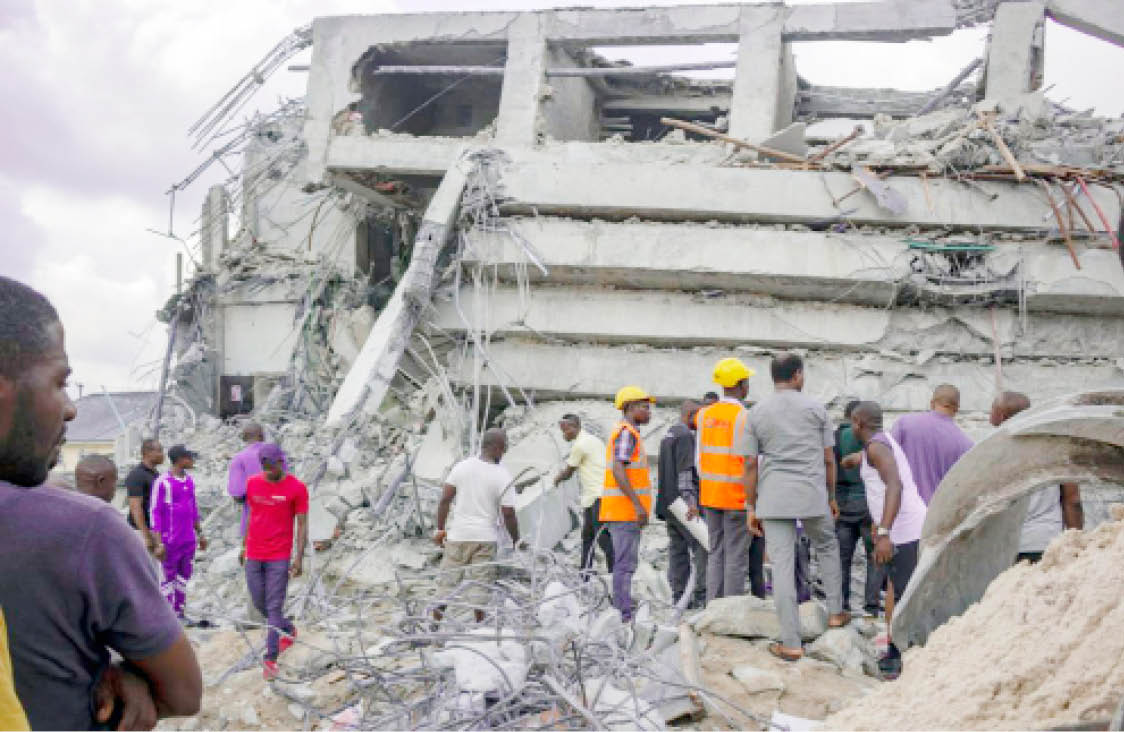Experts link collapsed Rivers building to poor monitoring, fraud
…building converted from one-storey to seven Some startling revelations have been made on what could be responsible for the collapse of a 7-storey building in Port Harcourt, Rivers State on November 23, 2018 which killed about 19 people and left scores of others injured. The revelations were made at the just concluded sitting in Port […]

FILE PHOTO: A seven-storey building that collapsed in Port Harcourt on November 23, 2018 Photo Credit: Jojo Falani
…building converted from one-storey to seven
Some startling revelations have been made on what could be responsible for the collapse of a 7-storey building in Port Harcourt, Rivers State on November 23, 2018 which killed about 19 people and left scores of others injured.
The revelations were made at the just concluded sitting in Port Harcourt of the judicial commission of inquiry on the collapsed building.
Rivers State Governor Nyesom Wike had in the first week of December 2018, set up the 7-man panel headed by Justice Adolphus Enebeli to ascertain whether the architectural, engineering and structural designs of the building were undertaken by competent and licensed experts.
Wike also directed the panel to investigate the circumstances that led to the collapse of the building located on Woji road in New GRA, Port Harcourt.
Speaking at the closing of the sitting, Justice Enebeli said the commission, which started hearing on December 27, 2018, heard from 46 witnesses and accepted 18 exhibits.
During the sitting which lasted 13 days, some of the witnesses including building experts gave shocking reasons on what could have led to the collapse of the building.
Daniel Erekosima, a geologist that conducted geotechnical soil test on the collapsed building said he certified the soil as being suitable for a one-storey building and not 7-storey.
A builder and supervisor at the site of the building, Emmanuel Enyang, said the building was initially designed for raft foundation but later changed to piling foundation after a second soil test.
Another witness and a Civil/Structural Engineer, Oti Emmanuel, described the nature of collapse as a plastic failure of the structure, adding that such incident could have been caused by excessive load heaped on the building.
The Director of Development Control in the State Ministry of Urban Development and Physical Planning, Mina Aprioku, told the commission that when he visited the collapsed building site in mid-2017, the engineers were working in compliance with the approved plan.
Aprioku pointed out that the ministry does not have enough manpower, particularly professional staff such as architects, quantity surveyors and engineers, a situation which, he said, made them to engage the services of ad hoc compliance team to help in monitoring.
Another witness, who is the Director of Building Plan, Ministry of Urban Development and Physical Planning, Edmund Obinna, told the panel that the immediate past commissioner for Urban Development, Dr. Reason Onyia, ordered the owner of the collapsed building during the 2018 revalidation process to produce the original 2014 approved plan of the building.
He said there was need to carry out a total overhaul of the ministry, noting that the Physical Planning Law of 2013 governing urban development in the state was being breached.
A survivor, who was a labourer at the collapsed building site, Smith Akaine, told the commission that the building collapsed at about 5:00pm when they were rounding off for the day, adding that some of the workers at the site had gone to buy food.
He said the building collapsed gradually and finally came down within 10 minutes.
A former commissioner for Urban Development and Physical Planning, Dr. Onyia, during cross examination, said the compliance team he worked with was already constituted before he came in, adding that the team helped the ministry to generate more revenue during his tenure through monitoring and detection of fake building plans.
Dr. Onyia also said the ministry had no professional architect to interpret drawings, adding that it hired the services of consulting agents who were professionals to interpret building drawings, stressing that he also relied on reports presented to him by directors in the ministry.
He stated that it was in the process of revalidation of the collapsed 7-storey building that it was discovered that the plan was missing, but that the building registration was later found. He said he ensured the authenticity of relevant documents before approval.
Another past commissioner in the state Ministry of Urban Development and Physical Planning, Dr Tammy Danagogo, was not happy with some top officials in the ministry whom he accused of dereliction and compromise in the discharge of their duties.
Danagogo accused the immediate past commissioner and directors in the ministry of playing a major role in the collapsed building.
Danagogo, who served as commissioner in the ministry from October 2011 to December 2013, made the allegation when he appeared before the commission of inquiry.
The former commissioner said before he assumed office, there were many sharp practices in the ministry, including indiscriminate approval of building plans by directors in the ministry.
“Every director approved plans; they (the directors) all had their boys, who would meet prospective clients and take them to their masters. In most cases, the proper thing was not done.
“As a result, I set up a committee consisting members of the Nigerian Society of Engineers, Nigerian Institute of Architects and other professional bodies. We restructured the system and came up with a template for building plan approval and a checklist,” Danagogo was quoted as saying.
The owner of the building, Joseph Alagoa, in his presentation said, “I paid all the necessary government fees before the project commenced in January 2017. The architect I hired recruited all the workers, including the professionals on the site.
“I usually go to the site any time I was in town to check the work.”
